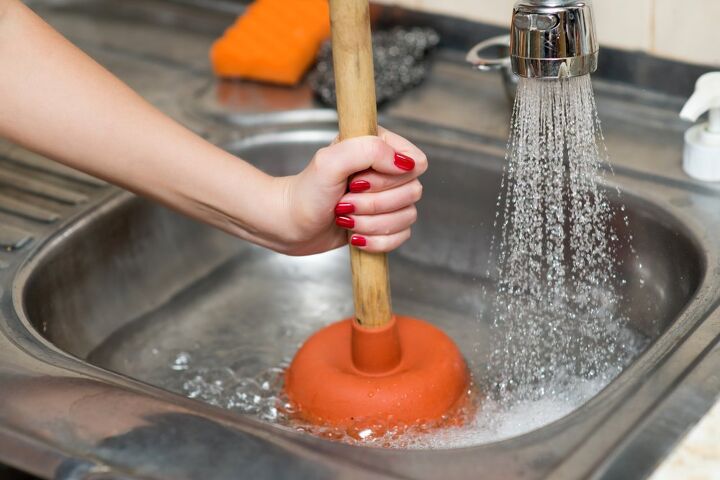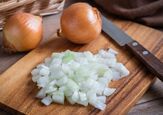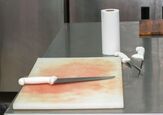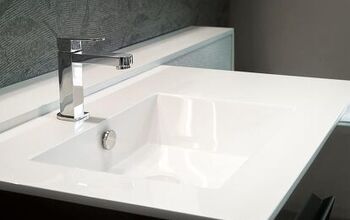How To Fix A Slow Draining Sink With A Garbage Disposal

Garbage disposal units mounted in kitchen sinks are some of the handiest home appliances available to homeowners today. These under sink gadgets make short work of small amounts of food waste by grinding and flushing them away. Garbage disposals are handy until they don’t work, and you face a slow draining sink.
Unplug the garbage disposal and mix ½ white vinegar with ¾ cup baking soda pour the solution down the drain. Rinse the drain with hot water for 2-5 minutes to flush the clog away. Fish clogs out of the drain with a pair of tongs if you spot food waste in the disposal.
A clogged or slow draining sink with a garbage disposal needs quick attention. Standing water in a sink can cause bigger problems. Standing water can stain the sink beyond repair or become a source of bad smells. The standing water may even damage the internal parts of the garbage disposal.
Do You Need to Hire a Plumber?
Get free, zero-commitment quotes from pro contractors near you.

Step 1 – Unplug the Garbage Disposal
Never, under any circumstance, work on a garbage disposal when plugged into the outlet. Unplugging the garbage disposal is especially important if you are working inside the garbage disposal to unblock the impellers or remove objects. If the garbage disposal comes on while you are working, you can suffer serious injuries.
Step 2 – Dissolve the Clog if Possible
Food waste can build up in the garbage disposal and clog the drain below the impeller. Grease and fat are the chief culprits in this kind of clog. It is almost impossible to clean the area of the drain beneath the impellor blade by completely disassembling the garbage disposal.
One effective method is to use a drain cleaner you can make at home. Mix ¾ cup baking soda with ½ cup white vinegar. Immediately pour this mixture into the garbage disposal and allow the cleaning solution to sit for a few minutes. The mixture will fizz and bubble.
When the mixture has stopped fizzing and bubbling in the garbage disposal, rinse the drain. Turn on the hot water tap and let the water run down the drain. Leave the water running for several minutes. Plenty of hot water should flush the softened material into the main drain.
You may need to repeat this step several times for stubborn clogs.
Step 3 – A Persistent Clog
If the slow drain through the garbage disposal persists, you need to check for large objects or obstructions in the garbage disposal. There may be larger pieces of food waste blocking the drain.
Use a flashlight to peer into the opening of the garbage disposal. You may be able to see the offending food waste or other objects in the disposal. A pair of tongs is useful for retrieving larger objects blocking your garbage disposal
CAUTION! Never, under any circumstances, stick your hand into a garbage disposal. Even if the machine is unplugged, your hand may become stuck in the small opening or your fingers cut by the impellors. Putting your hand in a live garbage disposal can cost your fingers or worse.
Step 4 – Clogs Below the Garbage Disposal
If the first three steps don’t work, the clog is probably in the drain below the garbage disposal. There are several options to try before reaching for the toolbox to disassemble the p-trap and drain.
You should try a plunger before going any further. Ensure that the drain line from the garbage disposal to the sink drain clamps tightly to the garbage disposal. Plunging a drain that has a loose connection at the drain line can have messy results.
Place the plunger over the opening of the garbage disposal in the sink. Adding a little water will give you a better seal. With the plunger seated and sealed over the opening, give the plunger several good stokes. A good plunge should loosen any clog inside the drain line.
Step 5 – When the Plunger Fails
When a good cleaning and a strong plunge don’t fix a slow draining garbage disposal, you have a problem deeper into the drain lines. The next most probable place for such a clog is the P-trap under the sink.
You may not be comfortable tackling the removal and cleaning of the P-trap under the sink. At this point, the services of a qualified plumber may be a good choice. If the clog is beyond the P-trap, the drain line probably needs to be snaked.
Step 6 – Time to Call a Professional
If the clog or slow drain problem persists, you may have problems with the drain lines in your home. When homeowners install a garbage disposal in an older home for the first time, they discover the drain lines are inadequate to handle the extra flow.
If your clog or slow drain situation continues after you have tried the various methods, consulting a qualified and licensed plumber is probably a good idea. A plumber can inspect your drain line with various tools and give you the best advice on proceeding.
What Causes A Garbage Disposal to Clog?
The major cause of garbage disposal clogs is putting the wrong kinds of food waste into the garbage disposal. Some foods should never go down a sink mounted garbage disposal, such as:
- Shells from shellfish such as clams
- Any grease or fat
- Cooking oils
- Large chunks of any vegetable
- Eggshells
- Cornhusks
- Artichokes
- Large amounts of potatoes or potato peels
- Banana skins
These types of food waste can quickly cause a garbage disposal to clog or drain slowly. Fats, oils, and greases, the so-called FOG’s, should never go down a drain. FOGS will cause a clog or blockage in a drain faster than almost any other material.
What To Do If You Can’t Avoid FOGs In Your Drain
There are times when you can’t avoid adding one of the FOG materials to your garbage disposal. Vegetables cooked in butter or other oils are one example. If you can’t avoid adding even small amounts of FOGs to your garbage disposal, try these tricks.
- Cool waste food first. Put the food waste with the FOG material in the refrigerator. Cooling will make the FOGs thicken and harden. Once the FOGs harden, the garbage disposal can break them into fine chucks that will go down the drain easily.
- Use cold water to flush the garbage disposal. Coldwater will help keep the hardened FOGs together. The last thing you want to do is to soften the FOGs again. Softening will allow the particles to clump together to make a clog more likely.
Other Problem Foods
Starchy foods such as rice, potatoes or potato peels and banana peels can be major clog makers. The garbage disposal action as it grinds away breaks the starches in these foods into a fine paste.
The starch in the paste acts as a natural glue and can thicken into a sticky cum that causes a clog and traps other particles of food waste as well. Once this mass hardens, it becomes almost impossible to remove.
Should I Clean my Garbage Disposal?
Absolutely! Like any other appliance in your kitchen, your garbage disposal needs a good cleaning occasionally. There are several ways to clean your garbage disposal
Ice Cubes and Lemon Peels
One recommended method of cleaning your garbage disposal is to add a handful of ice cubes to the disposal, drop in a few slices of lemon, a tablespoon of baking soda, and a teaspoon of bleach. Add more ice cubes and turn on the disposal.
Don’t run any water with this mixture. The ice cubes will scour the inside of the grinding chamber. The bleach will help remove any stubborn sticky foods, and the lemons will give your drain a pleasant clean odor.
Run the disposal with no water until you hear the grinding stop. Turn on the water and flush the garbage disposal thoroughly.
What You Should Never Do
Never use harsh chemical drain cleaners in your garbage disposal. These chemical clog removers often contain acids or lye, both of which can damage the synthetic parts of your garbage disposal. The acid drain cleaners can attack the metal of the impellors and damage them beyond repair.
Never stick your hand inside a garbage disposal. Putting your hand inside the grinding chamber is an invitation to disaster. Likewise, don’t stick utensils into the disposal to try and dislodge stuck material unless you are sure the garbage disposal is unplugged.
Do You Need to Hire a Plumber?
Get free, zero-commitment quotes from pro contractors near you.

Keeping Your Garbage Disposal Working
The best remedy for a clogged or slow draining garbage disposal is not letting it get clogged in the first place. Understanding what you can and cannot safely put into your garbage disposal is the first step in preventing clogs and slow drains. The second is proper maintenance. Clean your disposal using our tips and tricks in this article.
We hope this article has given you the help you need to remedy a clogged or slow-draining sink with a garbage disposal. As always, work safely and unplug that garbage disposal before performing any repairs. Good luck

Dennis is a retired firefighter with an extensive background in construction, home improvement, and remodeling. He worked in the trades part-time while serving as an active firefighter. On his retirement, he started a remodeling and home repair business, which he ran for several years.
More by Dennis Howard



























